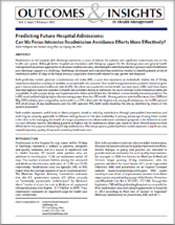Resource:
Predicting Future Hospital Admissions: Can We Focus Intensive Readmission Avoidance Efforts More Effectively?
The purpose of this study was to develop and test two predictive models to identify patients at risk for readmission that would be applicable in different settings based on the available patient data.
ABSTRACT
Readmission to the hospital after discharge represents a cause of distress for patients and significant unnecessary cost to the health care system. Although better hospital care transitions with follow-up support for the discharge plan and general health management are proven approaches to decrease readmission rates, identifying the admitted patients in greatest need of additional post-discharge support is a challenge. Healthways developed and evaluated two predictive models to identify patients at risk of readmission within 30 days of discharge among a population diverse with respect to age, gender and diagnosis.
Both predictive models generate a readmissions risk index (RRI), a score that represents an individual’s relative risk of 30-day readmission based on a variety of variables associated with this outcome. One model incorporates both a patient’s historical (prior year’s claims) and current health care data (hcRRI). The other uses a patient’s current health care data alone (cRRI), built from claims data that replicate data also available to health care providers during an admission, for use in settings in which historical claims are unavailable. A split-sample design was implemented to derive and validate the risk index in a commercially insured population. The hcRRI model yielded slightly higher discriminatory power than the cRRI model. Among patients admitted between June 2008 and May 2009 and who were assigned by each model to a 25% cohort with the highest risk among all admissions, the hcRRI captured 45% of all actual 30-day readmissions and the cRRI captured 44%, both nearly doubling the rate as identified by chance in the general population.
Both models represent useful tools to direct programs aimed at reducing readmissions through personalized interventions and each may be uniquely applicable to different settings based on the data availability. A primary advantage of using these models in the clinic or for managing the health of a larger population is to allow readmission-avoidance programs to be delivered at scale in a cost-effective manner. Identifying patients at highest risk for readmission allows care teams to direct limited resources most efficiently for the purpose of reducing 30-day readmissions. Effective programs guided by these models represent a significant step toward improving quality of care and containing healthcare costs.
INTRODUCTION
Readmission to the hospital for any reason within 30 days of discharge represents a setback to patients, caregivers and quality overseers, and is a source of significant cost to health insurers. Of insured adult patients who are admitted to the hospital, 11.3% are readmitted within 30 days. This number increases further among the uninsured and Medicare beneficiaries, with rates of 12.9% and 19.0% respectively.1 Readmission costs are typically 30% to 40% higher than the average expense of acute hospitalizations.2 The Medicare Payment Advisory Commission estimates that the U.S. government spends $12 billion annually on “potentially preventable readmissions” for Medicare alone.3 Jencks et al put the cost to Medicare of unplanned rehospitalizations even higher – $17.4 billion in 2004.4 Thus, readmission represents an important target for health care cost containment.
Due to the prevalence and cost of preventable readmissions, this area has become a focus for quality improvement efforts. Recent changes in policy and practice are intended to provide external motivation for such quality improvement. For example, in 2009 the Centers for Medicare & Medicaid Services began posting 30-day readmission rates for patients admitted for heart failure (HF), acute myocardial infarction (AMI) and pneumonia on its Hospital Compare website (www.hospitalcompare.hhs.gov). With public scrutiny as one driver of improvement, an even more direct repercussion ensued with passage of the Patient Protection and Affordable Care Act in 2010 (P.L. 111-148). Through this legislation, CMS will begin holding hospitals accountable for their readmission rates and adjusting payments to hospitals in 2013 according to their rate of “excess” vs “expected” Medicare readmissions for pneumonia, AMI, and HF.
But at a time when cost effectiveness is paramount, there is opportunity to implement scalable care transition and readmission avoidance programs by delivering individual interventions selectively to patients at the highest risk of discharge. Prior research has provided data to indicate that certain traits and care-related variables are associated with higher readmission rates. Examples include older age, gender, race, diagnosis, comorbidity, Medicaid coverage, and the length of stay during the index admission.7 Readmission rates also vary by hospital, state, and geographic region.8 However, less is known about these and other risk-related patient characteristics work in concert to affect an individual’s overall risk. Predictive models have been developed for this purpose, but have typically focused on a specific population, such as seniors, limiting broad applicability, and have demonstrated varying degrees of accuracy (Kansagara, 2011).9 A reliable and generalizable tool to predict the patients most likely to be readmitted would represent a foundational piece of a new generation of programs designed to more broadly impact readmission rates.
The purpose of this study was to develop and test two predictive models to identify patients at risk for readmission that would be applicable in different settings based on the available patient data. The cRRI was developed using “current” health care records, using data from the first day of a hospitalization as well as the period immediately preceding an admission, as would be available in a hospital setting. The hcRRI was developed using both the current data and historical claims data and would be applicable when complete claims data are available for the year prior to an admission. The models were intended to provide a valid and accurate tool to improve outcomes from programs intended to improve quality through reduced readmissions.

